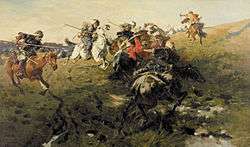Giray dynasty
| House of Giray | |
|---|---|
 | |
| Country | Crimean Khanate |
| Parent house | Borjigin Dynasty |
| Titles | |
| Founded | 15th century - Hacı I Giray |
| Dissolution |
Qasim: Astrakhan: Kazan: 1783 - |
The House of Giray (Crimean Tatar: Geraylar, كرايلر), also Girays,[1] were the Genghisid/Turkic dynasty that reigned in the Khanate of Crimea from its formation in 1427 until its downfall in 1783. The dynasty also supplied several khans of Kazan and Astrakhan between 1521 and 1550. Apart from the royal Girays, there was also a lateral branch, the Choban Girays (Çoban Geraylar). Before reaching the age of majority, young Girays were brought up in one of the Circassian tribes, where they were instructed in the arts of war. The Giray khans were elected by other Crimean Tatar dynasts, called myrzas (mırzalar). They also elected an heir apparent, called the qalgha sultan (qalğa sultan). In later centuries, the Ottoman Sultan obtained the right of installing and deposing the khans at his will.
During Ottoman Suzerainty
According to some scholars, the Girays were regarded as the second family of the Ottoman Empire after the House of Ottoman: "If Rome and Byzantium represented two of the three international traditions of imperial legitimacy, the blood of Genghis Khan was the third... If ever the Ottomans became extinct, it was understood that the Genghisid Girays would succeed them" (Sebag Montefiore. Prince of Princes: The Life of Potemkin. London, 2000).
During the 15th and early 16th centuries, the Giray Khan was second to the Ottoman Emperor, and superior to the Grand Vizier, in the Ottoman protocol. After the rebellion of Semiz Mehmed Giray, the sultan demoted the Crimean Khan to the level of Grand Vizier. The Giray Khans were also sovereigns of their own realm. They could mint coins, make law by decree, and had their own tughras.
Alliances

The Crimean Khanate also made alliances with the Polish-Lithuanian Commonwealth, and the Zaporizhian Sich. The assistance of İslâm III Giray during the Khmelnytsky Uprising 1648 contributed greatly to the initial momentum of military successes for Cossacks. While relationship with the Polish-Lithuanian Commonwealth was also exclusive as the home dynasty of Girays used to seek sanctuary in Lithuania in 15th century before establishing on Crimean peninsula.
Downfall
After the khanate's annexation by Imperial Russia in 1783, the last khan Şahin Giray remained nominally in power until 1787, when he took refuge in the Ottoman Empire, and was executed in Rhodes.
Other dynasts were permitted by the Russian authorities to reside in their Bakhchisaray palace. Selim III's young son, Qattı Giray, was converted by missionaries to Protestantism and married a Scottish heiress, Anne Neilson.[2]
After downfall
Since annexation, most of the Girays have lived in Turkey. Some of them, however, have lived in other countries. The last Crimean Khan, Şahin Giray's, grandsons and daughters lived in Bursa and Istanbul.
Line of succession to the former Crimean Khanate throne
Line of succession to the former Crimean Khanate throne (the United Kingdom)
- Prince Jezzar Giray, born 1959
- Prince Kadir Devlet Guirey, born 1961
- Prince Guven Giray, born 1963
- Prince Adil Sagat Temujin Guirey, born 1964
- Prince Caspian Azamat Guirey, born 1972
- Prince Genghis Karim Guirey, born 1992
- Prince Kadir Azamat Guirey, born 2001 Republic of Ireland
Line of succession to the former Crimean Khanate throne (Turkey)
- Ahmet Ibrahimoglu Giray Khan, Crimea, born 1870
- Omer Giray Khan, Constanta, born 1908
- Şahin Giray Khan, İzmir, born 1916
- Murat Giray Khan, İstanbul, born 1955
- Huseyin Giray Khan, Bursa, born 1959
- Şahin Giray Khan, İstanbul, born 1984
- Ismail Giray Khan, Canakkale, born 1992
- Salih Giray Khan İstanbul, born 1996
See also
- History of the Turks
- List of Turkic dynasties and countries
- List of Crimean khans
- List of Kazan khans
Notes
- ↑ Alternative spellings include Geray, Girey, Guirey, Ghirai, Ghiray, and Ghiray.
- ↑ Hakan Kırımlı, “Crimean Tatars, Nogays, and Scottish Missionaries: The Story of Kattı Geray and Other Baptised Descendants of the Crimean Khans”, Cahiers du monde russe 45, no. 1 (2004): 61–107.